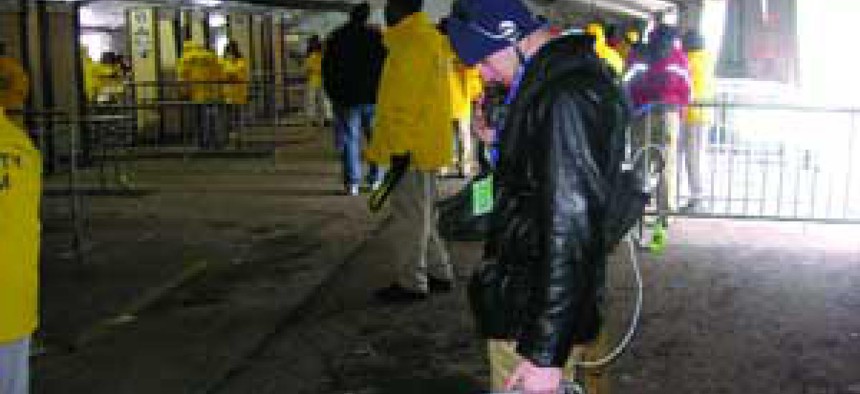Guard fields sensor fusion at Super Bowl


Connecting state and local government leaders
Amid the passes and tackles, punts and blocks, Jagger and Stones'and all those bizarre commercials that signify Super Bowl frenzy'a select group at Detroit's Ford Field was carrying out a more subtle activity during the NFL championship game in February. Members of the Michigan National Guard's 51st Civil Support Team were testing an innovative sensor technology for use, in this case, in a security setting at a public event attended by 65,000 people.

The Michigan National Guard used this year's Super Bowl to test a hazard monitoring system that feeds data wirelessly to a monitoring station
Members of the Michigan National Guard's 51st Civil Support Team were testing an innovative sensor technology for use, in this case, in a security setting at a public event attended by 65,000 people.
Equipped with paperback-size Sony Vaio U50s'handheld computers running Microsoft Windows XP Pro with sensing devices connected to a wireless network'soldiers posted at entry tents and scattered around the venue checked for the presence of hazardous materials and relayed data back to a single operations center. Data was stored in an IBM DB2 database.
Real-time data
If chemical or radiation levels had gone up as an individual walked through the entry tent, or if soldiers sweeping another area picked up some other chemical presence, that data could be sent back to the operations center wirelessly in real time for analysis and potential action.
The technology, called sensor data fusion, is the creation of Distributed Instruments LLC of Sterling Heights, Mich. Jeffrey Ricker, the company's chief executive officer, described sensor fusion as a way to create a single picture from multiple sensors.
The system uses an open-standard, plug-and-play server architecture called Transducer Data Exchange Protocol, or TDXP, that can scale to millions of networked sensors. Distributed Instruments' software and servers transport data wirelessly through a network to a command center via IEEE 802.11a/g and 802.16 WiMax.
The cost depends primarily on the number of handheld computers, but a setup similar to the 51st Civil Support Team's'12 handhelds and a base server'would run about $60,000.
While several tests of the technology were done last year with the Defense Department, the Super Bowl project was the first live deployment.
Capt. Philip Rusiecki, survey team leader for the 51st Civil Support Team, said the technology significantly streamlined the team's work.
'One of the things this technology helps us with is to eliminate the number of monitors our teams need to carry and manage,' he said. 'We have teams of two, and it can be burdensome to carry several different monitors, keep situational awareness, and report back readings. This technology reduces the number of communications our teams have to make and allows me to keep track of real-time data instead of relying on my soldiers to report back on radio. The teams can remain situationally aware without having to look too much at their equipment.'
Ricker said some training was required on the use of the new equipment, but nothing very rigorous. 'The computers have intuitive screens and are easy to use,' he said. 'Plus, today's soldiers are very technology savvy.'
Still in the research and development phase, nonetheless, the technology is expected to have additional applications for homeland security, as well as for health care, industrial process control and defense.
'All sensor data looks the same on the network,' Ricker said. 'You can use sensor networks for entire cities and military bases. The Energy and Defense departments are looking into that, as well as using it in building management and hospital settings. The technology can be used for all variety of purposes, whether measuring chemical levels in the air, biometric data in passports or the equipment conditions in truck fleets.'
Rusiecki is hoping that the technology will evolve to allow data to flow two ways.
'Just imagine using this in a real incident, when soldiers going down range are wearing full, bulky hazardous materials suits and, instead of having to transmit data, [they are] able to focus on the task,' he said. 'We're looking at expanding this, so we can one day not only take photos and video and give task lists, but, if we have a change of mission in the middle of a hot zone, send information both ways. That will help us out greatly.'
Caron Golden is a freelance writer in San Diego.
NEXT STORY: GPO's James to step down




